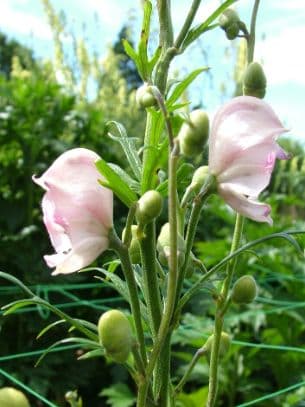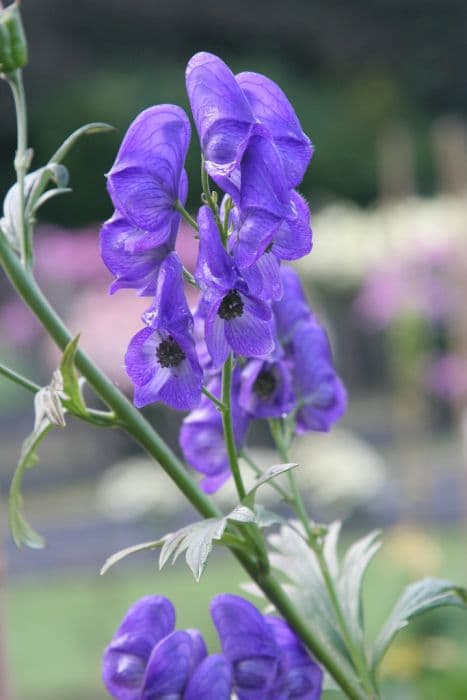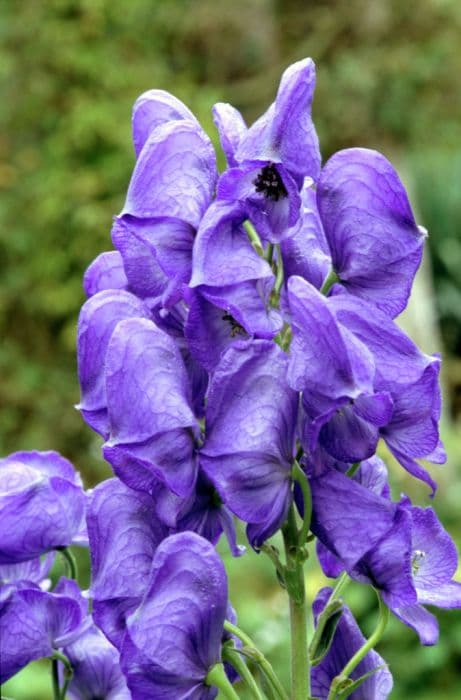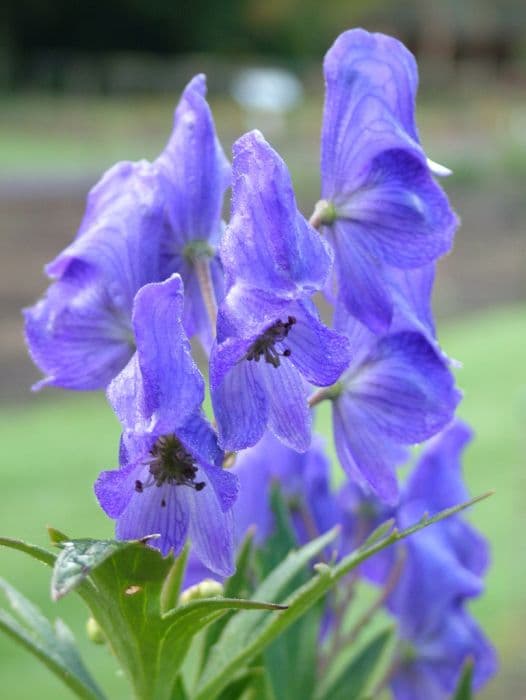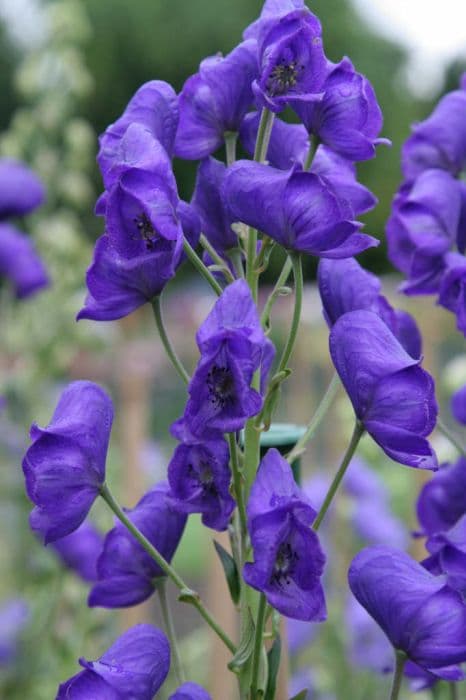Larkspur Delphinium 'Sandpiper'

ABOUT
The Delphinium 'Sandpiper' is an elegant plant known for its strikingly beautiful flowers. Its overall appearance is distinguished by tall spires adorned with a profusion of blooms. These blooms typically come in a range of blue shades, often described as sky-blue or pale blue, which can give any garden a touch of serene color. Some varieties may also exhibit hints of pink or purple within the flowers. The flowers themselves are shaped like little trumpets, with a prominent bee, or central tubular structure, which is often a darker color, adding to the visual interest of the plant. The foliage of the Delphinium 'Sandpiper' is comprised of deeply lobed leaves that are medium green in color, creating a lush background for the spectacular blooms. Its leaves are arranged in a way that provides a nice textured contrast to the smooth lines of the flower spires. These plants often lend a vertical element to garden designs due to the way their blooms stack neatly above the foliage. Blooming mainly during the early summer months, the Delphinium 'Sandpiper' can also have a second blooming period in late summer or early fall if conditions are optimal. Due to its color and stately form, this plant is perfect for adding height and color to flower beds and borders without specifying the actual dimensions of the plant.
About this plant
 Names
NamesSynonyms
Larkspur, Delphinium
Common names
Delphinium 'Sandpiper'.
 Toxicity
ToxicityTo humans
The plant commonly known as Larkspur is toxic to humans. All parts of the plant contain toxic alkaloids such as delphinine, which can cause serious poisoning. Symptoms of Larkspur poisoning may include nausea, vomiting, abdominal pain, muscle weakness, paralysis, and can lead to serious complications like respiratory failure and death if a significant amount is ingested.
To pets
Larkspur is also toxic to pets. The alkaloids present throughout the plant can affect pets in a similar way to humans, causing symptoms such as drooling, abdominal pain, muscle tremors, stiffness, weakness, seizures, and respiratory failure which could be potentially fatal without timely veterinary care.
 Characteristics
CharacteristicsLife cycle
Perennials
Foliage type
Deciduous
Color of leaves
Green
Flower color
Blue
Height
4-6 feet (1.2-1.8 meters)
Spread
1-2 feet (0.3-0.6 meters)
Plant type
Herb
Hardiness zones
3
Native area
Europe
Benefits
 General Benefits
General Benefits- Attractive to pollinators: Delphinium 'Sandpiper', commonly known as larkspur, draws bees, butterflies, and other beneficial insects, enhancing pollination in the garden.
- Aesthetic appeal: With its tall spikes of blueish-purple flowers, larkspur adds vertical interest and a splash of color to garden settings.
- Cut-flower garden addition: The flowers of larkspur make excellent cut flowers for arrangements due to their height and vibrant colors.
- Seasonal interest: Larkspur typically blooms in late spring to early summer, providing a seasonal display when many other plants are yet to peak.
- Garden structuring: The height of larkspur helps to provide structure to garden beds and can be used effectively for background planting.
- Companion planting: Larkspur can be paired with other garden plants to create complementary color schemes and textural contrasts.
- Resilience to pests: Larkspur is relatively resistant to pests, meaning less maintenance and fewer chemical treatments are necessary.
- Native habitat enhancement: By planting larkspur, which is native to certain areas, gardeners can help support local ecosystems and wildlife.
 Medical Properties
Medical PropertiesThis plant is not used for medical purposes.
 Air-purifying Qualities
Air-purifying QualitiesThis plant is not specifically known for air purifying qualities.
 Other Uses
Other Uses- Delphiniums can be used in natural dye production, with various shades of blue obtainable from the petals.
- The tall and sturdy nature of delphinium stalks allows them to be used as natural supports for other plants in the garden.
- Delphinium flowers are edible and can be used to garnish salads, desserts, or drinks for a bright pop of color.
- The spent blooms and stems can be added to compost bins to enrich garden soil as they decompose.
- Delphiniums can be planted to provide a habitat for beneficial insects like bees and butterflies, aiding in pollination of surrounding plants.
- These plants can be used in cut flower arrangements to provide a vertical accent due to their height and prominent spikes of flowers.
- Dried delphinium flowers can be utilized in potpourris or sachets for natural home fragrance options.
- Delphinium petals can be pressed and used in botanical art and craft projects, such as creating handmade paper or bookmarks.
- The plants can be used as a natural fence or border to define areas within a garden due to their height and growth habit.
- Delphinium flowers are often used in celebrating and decorating for events due to their bright and vivid colors and large flower spikes.
Interesting Facts
 Feng Shui
Feng ShuiThe Delphinium is not used in Feng Shui practice.
 Zodiac Sign Compitability
Zodiac Sign CompitabilityThe Delphinium is not used in astrology practice.
 Plant Symbolism
Plant Symbolism- Protection and Safety: Delphinium 'Sandpiper', commonly known as Larkspur, often symbolizes protection due to its historical use in ancient rituals to ward off danger and evil spirits.
- Open Heart and Ardent Attachment: The delicate and open structure of the larkspur flower suggests an open heart and is frequently associated with intense love and strong bonds.
- Lightness and Levity: The airy quality of the blooms and their towering height often lead to their association with lightness and a sense of whimsy or levity.
- Romantic Feelings: Larkspur flowers, particularly their graceful shape and vibrant colors, are often recognized as symbols of romantic feelings and affection.
- New Opportunities: The growth pattern of larkspur, reaching upward as it blooms, symbolizes new opportunities and striving towards achieving one's goals.
- July Birth Flower: As the birth flower for July, the larkspur represents celebration and positivity that is characteristic of those born in this month.
 Water
WaterLarkspur requires consistent moisture, especially during the growing season. Water the plant deeply once a week, providing about 1 to 1.5 inches of water, which can be roughly equivalent to 0.5 to 0.75 gallons for a medium-sized plant. During hot, dry spells, you may need to water twice a week. Ensure that the soil is well-draining to prevent waterlogging, as larkspur does not tolerate standing water. Reduce watering in the winter when the plant is dormant.
 Light
LightLarkspur thrives in full sun to light shade conditions. For optimal growth, plant it in a location where it will receive at least six hours of direct sunlight per day. While the larkspur can tolerate partial shade, too much shade may result in weaker stems and fewer blooms. Choose a spot in your garden that is well-lit and away from the full afternoon sun, which can be too intense in hot climates.
 Temperature
TemperatureLarkspur prefers moderate temperatures and can generally handle climates within the range of 50°F to 75°F. The plant can withstand short periods of colder temperatures but may experience damage if exposed to temperatures below 40°F. In extreme heat above 85°F, larkspur may not perform as well, so it is ideal to provide some afternoon shade in particularly hot climates.
 Pruning
PruningPrune larkspur to encourage bushiness, maintain its shape, and remove spent flowers. Deadheading, or cutting off the faded flowers, often stimulates a second bloom. Prune larkspur back by a third after the first bloom has finished, typically in midsummer. Also, remove any damaged or diseased stems as needed throughout the growing season.
 Cleaning
CleaningAs needed
 Soil
SoilLarkspur 'Sandpiper' requires well-draining soil with a pH of 6.0 to 7.5. A best soil mix for this plant would be a blend of loamy soil, compost, and coarse sand to ensure proper drainage and fertility. Regular amendments with organic matter can help maintain soil quality.
 Repotting
RepottingLarkspur 'Sandpiper' typically does not require frequent repotting as it is often treated as a biennial or perennial. It should be repotted only when it outgrows its current container or when soil quality deteriorates, usually every 2-3 years.
 Humidity & Misting
Humidity & MistingLarkspur 'Sandpiper' thrives best in moderate humidity conditions, ideally between 40% to 60%. Excessive humidity can lead to fungal diseases, so it is essential to maintain good air circulation around the plant.
 Suitable locations
Suitable locationsIndoor
Ensure bright indirect light and cool temperatures.
Outdoor
Full sun to partial shade, shelter from strong winds.
Hardiness zone
3-7 USDA
 Life cycle
Life cycleThe life of the Delphinium 'Sandpiper', commonly known as larkspur, begins with seed germination, typically in the early spring when soil temperatures warm. Seedlings emerge and develop true leaves, gradually forming a small rosette close to the soil surface. As the plant matures, it elongates and produces characteristic tall spikes adorned with delicate, colorful flowers, typically during late spring to early summer. After pollination, often by bees or butterflies attracted to the blooms, the flowers develop into fruit that contains seeds. As the growing season ends, the plant enters a period of dormancy, especially in regions with cold winters, where it dies back to the ground. With the return of favorable conditions, the larkspur will sprout again from the surviving root system or the dispersed seeds will initiate a new generation.
 Propogation
PropogationPropogation time
Spring to Summer
The Delphinium 'Sandpiper', commonly known as Larkspur, is best propagated by seed. The optimal time for sowing Delphinium seeds is in spring when the soil has warmed to at least 55°F (13°C), ensuring that there's no risk of frost which can damage the young seedlings. To propagate, surface sow the fine seeds in a well-draining soil mix, pressing them gently into the surface without covering, as they require light to germinate. Keep the soil moist but not waterlogged, and place the seed trays in a bright area without direct sunlight. Seedlings typically emerge within 2 to 3 weeks and can then be carefully transplanted to individual pots until they are strong enough to be moved to their final location in the garden.

